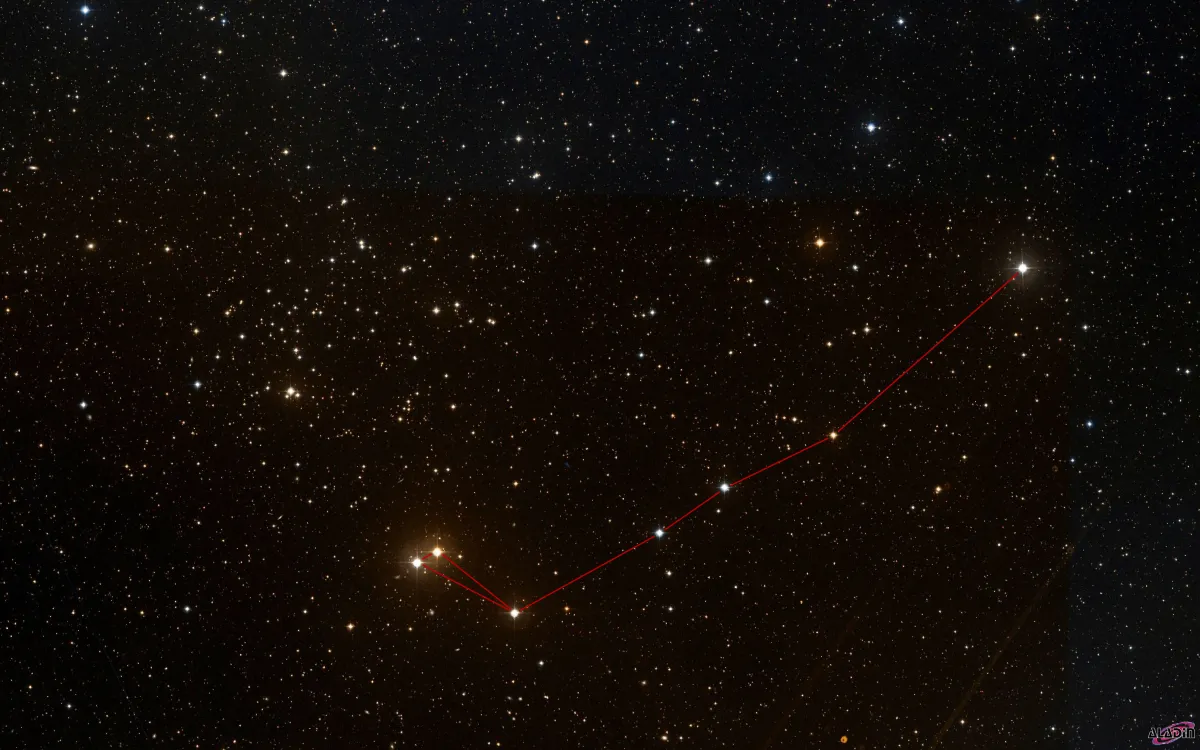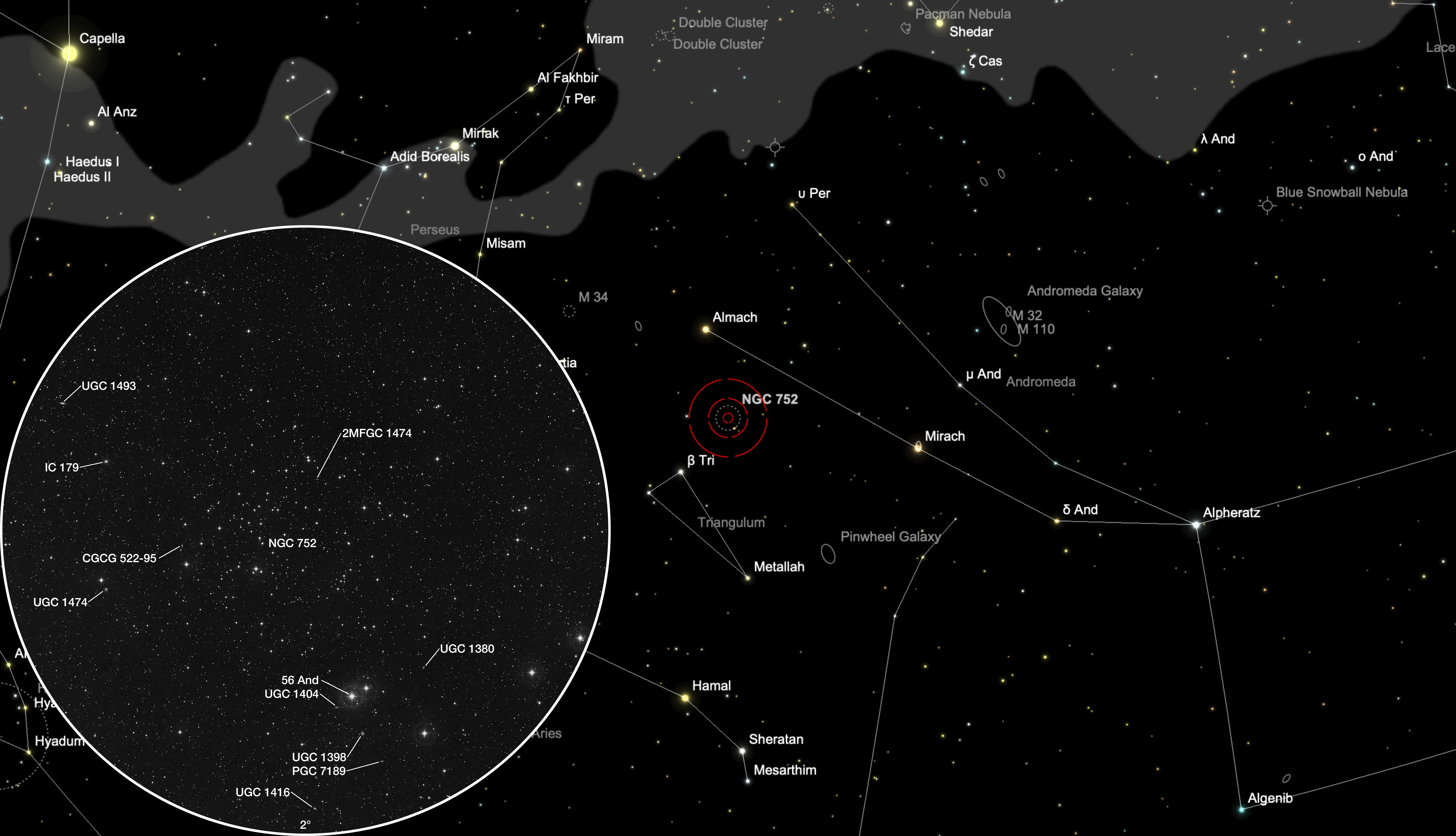Open Cluster NGC 752

History
This open cluster was probably first seen by Italian astronomer Giovanni Batista Hodierna before 1654. He observed in Palermo, Sicily using a small galilean refractor with 20x magnification. His mentions of a nebula «juxta Triangulum» mentioned on pages. 7, 11 and 48 could also refer to Messier 33. His classification of nebula was: nebulous for the naked eye, but resolved in a telescope. Unfortunately his publication was little known outside Sicily. It had been rediscovered in the 1980s. [128, 196, 217, 277, 364]
William Herschel first observed this cluster on 24 August 1783 with his 6.2-inch reflector. His sister Caroline independently discovered the cluster on 29 September 1783 with her 4.2 inch comet-seeker reflector. [364] Later on 21 September 1786 while doing his sweeps using his 18.7 inch telescope William Herschel listed the cluster as VII 32 (class VII = pretty much compressed clusters of large or small stars). He noted: «A very large coarsely scattered cluster of very large stars, irregularly round, very rich, takes up 1/2 degree like a nebulous star to the naked eye.» [464] Dreyer added this cluster as NGC 752 to his «New General Catalogue» in 1888. [313]
Physical Properties
NGC 752 is an old and loose open cluster. The age is estimated to 1.12 billion (109) years. [138]
| Designation | NGC 752 |
| Type | OCL (III1m) |
| Right Ascension (J2000.0) | 01h 57m 35.0s |
| Declination (J2000.0) | +37° 50' 00" |
| Diameter | 75 arcmin |
| Visual magnitude | 5.7 mag |
| Metric Distance | 0.458 kpc |
| Dreyer Description | Cl, vvL, Ri, st L & sc |
| Identification, Remarks | WH VII 32; h 174; GC 457; OCL 363 |
Background Galaxies
A number of small and faint background galaxies can be seen through the open cluster NGC 752. These may pose a nice challange for CCD imagers and large dobsonian users. The largest and brightest of these is IC 179, discovered on 28 June 1890 by Lewis Swift using the 16 inch refractor at Warner Observatory. [364] The other galaxies are mostly from the «Uppsala General Catalogue of Galaxies» (UGC), compiled by Peter Nilson in 1973. [459]
| PGC | RA | Dec | Type | Dim | Btot | HRV | PA | Names |
|---|---|---|---|---|---|---|---|---|
| PGC 7124 | 01 54 57.7 | +37 20 33 | S | .9 x .6 | 15.4 | 165 | UGC 1380, CGCG 522-59, KUG 151+370 | |
| PGC 7220 | 01 55 58.6 | +37 07 49 | S | 1.2 x 1.1 | 14.7 | 5218 | UGC 1398, MCG 6-5-54, CGCG 522-69, IRAS 1530+3653 | |
| PGC 7263 | 01 56 23.8 | +37 12 58 | SB | 1.1 x .6 | 15.3 | 4458 | 100 | UGC 1404, MCG 6-5-56, CGCG 522-73 |
| PGC 7300 | 01 56 46.1 | +36 53 14 | S | 1.2 x .6 | 14.8 | 65 | UGC 1416, MCG 6-5-59, CGCG 522-81 | |
| PGC 7489 | 01 58 55.9 | +37 44 45 | 15.6 | CGCG 522-95 | ||||
| PGC 7579 | 02 00 11.3 | +37 36 14 | SB | 1.3 x 1.1 | 14.7 | 4044 | 15 | UGC 1474, MCG 6-5-76, CGCG 522-100 |
| PGC 7581 | 02 00 11.5 | +38 01 15 | E | 1.8 x 1.5 | 13.4 | 4188 | 110 | IC 179, UGC 1475, MCG 6-5-75, CGCG 522-101 |
| PGC 7646 | 02 00 55.0 | +38 12 42 | SB | 1.8 x .7 | 13.9 | 4107 | 87 | UGC 1493, MCG 6-5-77, CGCG 522-102, IRAS 1579+3758 |
Finder Chart
The open cluster NGC 752 can be found in the constellation Andromeda, lying about halfway between the stars Almach (γ Andromedae) and β Trianguli. On a dark site it is visible to the naked eye. With binoculars or a small telescope (ca. 4° field of view) the asterism «Golf Putter» with the cluster NGC 752 as the ball can be identified. The two bright stars with 56 And are the club head. [129] If you own a large aperture telescope, increase magnification and use the 2° closeup of the finder chart for hunting down the tiny background galaxies. On 25 October it is in opposition to the Sun and crosses the meridian at local midnight. The best time for observation is in the months June to March.
